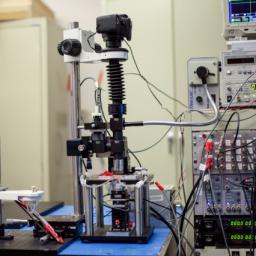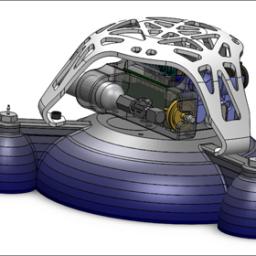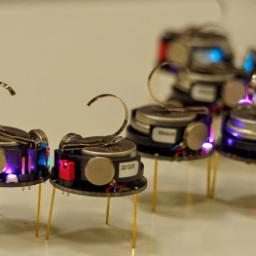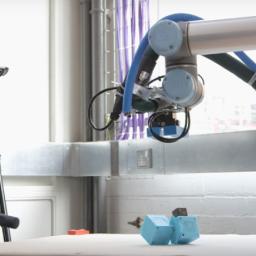
A team of scientists has, for the first time,
created a two-dimensional sheet of boron. This new 2D material is named as borophene.
Scientists have been interested in two-dimensional materials for their unique characteristics, particularly involving their electronic properties. Borophene is an unusual material because it shows many metallic properties at the nanoscale even though three-dimensional, or bulk, boron is nonmetallic and semiconducting.

State-of-the-art atomic force microscopes (AFMs) are designed to capture images of structures as small as a fraction of a nanometer - a million times smaller than the width of a human hair. Atomic force microscopes typically scan samples using an ultrafine probe, or needle, that skims along the surface of a sample, tracing its topography, similarly to how a blind person reads Braille.
http://news.mit.edu/2015/new-microscope-real-time-videos-nanoscale-1214Scientists have turned individual cells into miniature lasers by injecting them with droplets of oil or fat mixed with a fluorescent dye that can be activated by short pulses of light. This finding could help to broaden how light is used for both medical diagnosis and treatment. The system was devised by Harvard Medical School scientiest, and it uses droplets of fat or oil within a cell to reflect and amplify light, generating a laser. Conventional luminescent probes, which include fluorescent dyes and proteins, have relatively broad emission spectra. This limits the number of probes that can be used simultaneously, because it is often difficult to distinguish these sources of luminescence from the broad background emissions of naturally occurring molecules in tissue.
http://www.deccanherald.com/content/494474/oil-droplets-turn-cells-tiny.htmlBy now, most people feel comfortable conducting online financial transactions on the Web. The cryptographic schemes that protect online banking and credit card purchases have proven their reliability over decades. But right now, there is no effective way to prevent misuse of your data by the people authorized to access it, say for example a bank employee can still access your data, and frequently we are reading news about misuse of the data by the bank employees. i-e Once you share your data with the bank, Healthcare system or any other private company, for your online transactions, you don't have any control over who exactly is using or misusing your data.
http://news.mit.edu/2014/whos-using-your-data-httpa-0613
Traditional industrial robots are rigid as well as fast, precise, and powerful. Their speed and accuracy come at the cost of complexity and can often pose a danger to humans who get too close. Soft robots are adaptable and resilient but slow, difficult to fabricate, and challenging to make autonomous because most motors, pumps, batteries, sensors, and microcontrollers are rigid. But what if you could combine the autonomy and speed of a rigid robot with the adaptability and resiliency of a soft robot, and do so relatively cheaply and quickly?
http://wyss.harvard.edu/viewpressrelease/207/a-jump-for-softbodied-robots
Researchers at Harvard university had demonstrated a self-organizing swarm which was formed by one thousand little robots known as "Kilobots". The robots begin to blink at one another and then gradually arrange themselves into a five-pointed star, once after a computer scientist gave a command for forming a sea Star shape to 1,024 little bots simultaneously via an infrared light. Just as single cells can assemble into complex multicellular organisms, the individual Kilobots can follow simple rules to autonomously assemble into predetermined shapes.
http://www.eecs.harvard.edu/ssr/projects/progSA/kilobot.htmlThe U.S Space Company SpaceX has successfully landed the first stage of its Falcon 9 rocket at a landing pad in Cape Canaveral, Florida after launching 11 satellites into orbit.
It is historically very important achievement.
It is the first time spaceX has been able to gently touch down the Falcon 9 post-launch. It is a big first step toward reusable rocket.
First stage of falcon 9 is 14-story tall.
http://www.theverge.com/2015/12/21/10640306/spacex-elon-musk-rocket-landing-successThe polarization of light is the physical phenomenon behind polarized sunglasses and most 3-D movie systems. MIT researchers have shown that by exploiting the polarization of light they can increase the resolution of conventional 3-D imaging devices as much as 1,000 times. The technique could lead to high-quality 3-D cameras built into cellphones, and perhaps to the ability to snap a photo of an object and then use a 3-D printer to produce a replica. The work could also help the development of driverless cars. The researchers call this new system Polarized 3D.
http://news.mit.edu/2015/algorithms-boost-3-d-imaging-resolution-1000-times-1201
Researchers have observed the process of evolution by natural selection at work in robots, by constructing a 'mother' robot that can design, build and test its own 'children', and then use the results to improve the performance of the next generation, without relying on computer simulation or human intervention.
Researchers led by the University of Cambridge have built a mother robot that can independently build its own children and test which one does best; and then use the results to inform the design of the next generation, so that preferential traits are passed down from one generation to the next.
Without any human intervention or computer simulation beyond the initial command to build a robot capable of movement, the mother created children constructed of between one and five plastic cubes with a small motor inside.
Full article:
http://robotglobe.org/a-mother-robot-that-can-design-build-and-test-its-own-children/3D printing Technology is growing very fast upto the level of printing a building itself. A professor is working on technology named as Contour Crafting which can print an entire 2,500 sqft house in 20 hours.
Behrokh Khoshnevis is a professor of Industrial & Systems Engineering and is the Director of Manufacturing Engineering Graduate Program at the University of Southern California (USC). He is active in CAD/CAM, robotics and mechatronics related related research projects. He was able to make a printhead that can extrude wet cement in such a way that the cement is able to keep its form as each successive layer is printed.
Using the Contour Crafting (CC) developed by Behrokh Khoshnevis , a single house or a colony of houses, each with possibly a different design, may be automatically constructed in a single run, embedded in each house all the conduits for electrical, plumbing and air-conditioning.
The professor believes that his technology would make the construction of efficient buildings so cheap and efficient that we could print houses for Millions of poor people living in slums across the world. And, this kind of building process will avoid the killings and injuries related to construction accidents.
http://3dprinting.com/news/future-talk-3d-printing-entire-house-less-20-hours/ A team of scientists has, for the first time, created a two-dimensional sheet of boron. This new 2D material is named as borophene.
A team of scientists has, for the first time, created a two-dimensional sheet of boron. This new 2D material is named as borophene.


